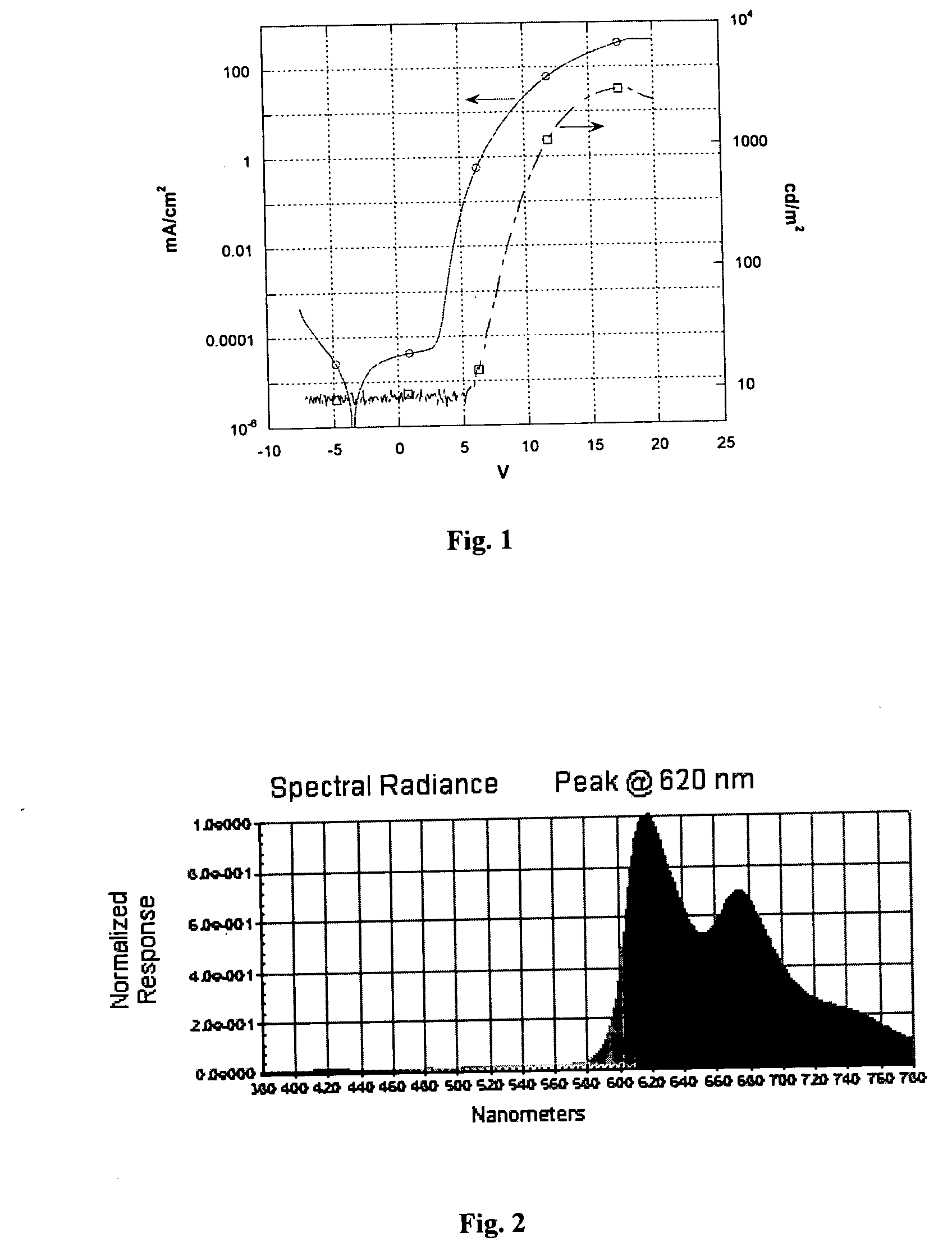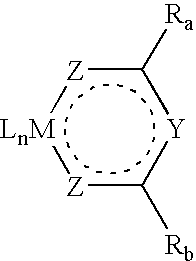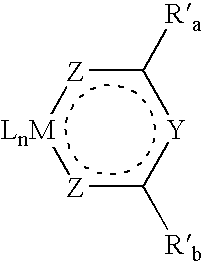Aromatic monomer- and conjugated polymer-metal complexes
a monomer and metal complex technology, applied in the field of aromatic polymermetal complexes, can solve the problems of unpredictability of the properties of the final polymer, incomplete reaction of pendant ligands with metal complexing reagents, etc., and achieve the effect of affecting the effect of minimal amoun
- Summary
- Abstract
- Description
- Claims
- Application Information
AI Technical Summary
Benefits of technology
Problems solved by technology
Method used
Image
Examples
example 1
Preparation of a Dibromobenzene Monomer-Iridium Complex (Structure III)
A. Preparation of 1-(2,5-Dibromo)phenoxy-2,4-pentadione Precursor
A mixture of 2,5-dibromophenol (12.6 g, 50 mmol), ethyl bromoacetate (8.0 g, 48 mmol), and potassium carbonate (20 g, 150 mmol) in acetone (150 mL) was refluxed under nitrogen for 24 h. After being cooled to room temperature, the reaction mixture was filtered and washed with acetone. After the removal of the solvent, the residue was recrystallized from ethanol to give ethyl(2,5-dibromophenoxy)acetate.
In the next step, sodium hydride (4.56 g, 0.19 mol) was added to a solution of anhydrous acetone (12.3 g, 0.213 mol) dissolved in 250 mL of dimethoxyethane under nitrogen at room temperature. The mixture was stirred at room temperature for 15 minutes, after which ethyl(2,5-dibromophenoxy)acetate (12.0 g, 0.0335 mol) was added in one portion. The reaction mixture was stirred under nitrogen at 80° C. for 16 hours. After cooling, the pH of the mixtur...
example 2
Preparation of Metal Complex Containing Polymer
To a stirred mixture of 9,9-di(1-hexyl)fluorene-2,7-diboronic acid ethylene glycol ester (1.9268 g, 4.08 mmol), 2,7-dibromo-9,9-di(1-hexyl)fluorene (1.7150 g, 3.48 mmol), N,N-diphenyl-1,3-dibromoaniline (0.1624 g, 0.40 g), dibromobenzene monomer-iridium complex made in Section C in Example 1 (0.160 g, 0.12 mmol), Aliquat® 336 phase transfer catalyst (0.75 g) in toluene (50 mL) was added tetrakis(triphenylphosphine)palladium(0) (3.6 mg) and 2M aqueous sodium carbonate solution (11 ml) under nitrogen. The reaction mixture was stirred at 101° C. under nitrogen for 20 h, whereupon bromobenzene (0.15 g in 10 mL of toluene) was added to cap the polymer under the same reaction conditions for 3 h. Then, phenylboronic acid (0.4 g) and tetrakis(triphenylphosphine)palladium(0) (3 mg of dissolved in 10 mL of toluene) was added to double cap the polymer under the same reaction conditions for overnight. After the reaction mixture was allowed cool t...
example 3
Light-Emitting Devices of a Metal Complex Containing Polymer
A thin film of poly(ethylenedioxythiophene) / polystyrenesulfonic acid (PEDOT) was spin-coated on a ITO (indium tin oxide)-coated glass substrate, at a thickness of 80 nm. Then, a film of the metal complex containing polymer made in Example 2 was spin-coated on the PEDOT film at a thickness of 80 m from a solution in xylenes. After drying, a thin layer (3 nm) of LiF was deposited on the top of the polymer layer by thermal evaporation, followed by the deposition of a cathode calcium (10-nm thick). An additional aluminum layer was applied by evaporation to cover the calcium cathode. By applying a bias (ITO wired positively) on the resultant device, red light emission was obtained. The brightness of the emission reached 200 cd / m2 at about 9 V with the luminance efficiency of 2 cd / A. The device reached the brightness of 1000 cd / m2 at ˜12 V at the luminance efficiency of 1.8 cd / A.
FIG. 1 illustrates the current and light output ...
PUM
| Property | Measurement | Unit |
|---|---|---|
| structures | aaaaa | aaaaa |
| Ra | aaaaa | aaaaa |
| electroluminescent | aaaaa | aaaaa |
Abstract
Description
Claims
Application Information
 Login to View More
Login to View More - R&D
- Intellectual Property
- Life Sciences
- Materials
- Tech Scout
- Unparalleled Data Quality
- Higher Quality Content
- 60% Fewer Hallucinations
Browse by: Latest US Patents, China's latest patents, Technical Efficacy Thesaurus, Application Domain, Technology Topic, Popular Technical Reports.
© 2025 PatSnap. All rights reserved.Legal|Privacy policy|Modern Slavery Act Transparency Statement|Sitemap|About US| Contact US: help@patsnap.com



